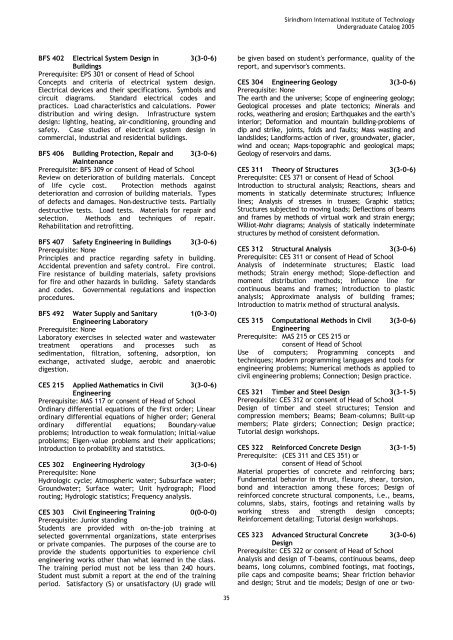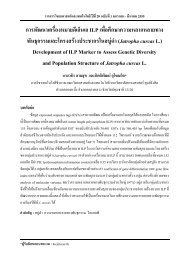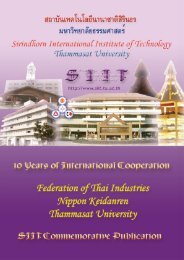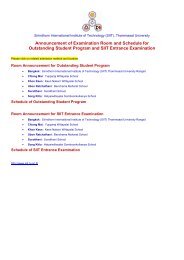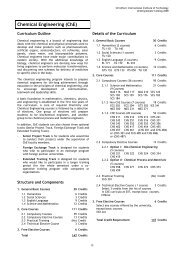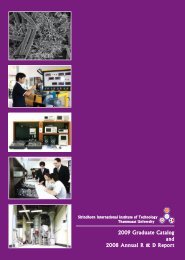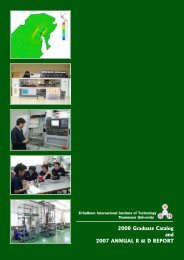Course Description - Sirindhorn International Institute of Technology
Course Description - Sirindhorn International Institute of Technology
Course Description - Sirindhorn International Institute of Technology
Create successful ePaper yourself
Turn your PDF publications into a flip-book with our unique Google optimized e-Paper software.
<strong>Sirindhorn</strong> <strong>International</strong> <strong>Institute</strong> <strong>of</strong> <strong>Technology</strong><br />
Undergraduate Catalog 2005<br />
BFS 402 Electrical System Design in 3(3‐0‐6)<br />
Buildings<br />
Prerequisite: EPS 301 or consent <strong>of</strong> Head <strong>of</strong> School<br />
Concepts and criteria <strong>of</strong> electrical system design.<br />
Electrical devices and their specifications. Symbols and<br />
circuit diagrams. Standard electrical codes and<br />
practices. Load characteristics and calculations. Power<br />
distribution and wiring design. Infrastructure system<br />
design: lighting, heating, air‐conditioning, grounding and<br />
safety. Case studies <strong>of</strong> electrical system design in<br />
commercial, industrial and residential buildings.<br />
BFS 406 Building Protection, Repair and 3(3‐0‐6)<br />
Maintenance<br />
Prerequisite: BFS 309 or consent <strong>of</strong> Head <strong>of</strong> School<br />
Review on deterioration <strong>of</strong> building materials. Concept<br />
<strong>of</strong> life cycle cost. Protection methods against<br />
deterioration and corrosion <strong>of</strong> building materials. Types<br />
<strong>of</strong> defects and damages. Non-destructive tests. Partially<br />
destructive tests. Load tests. Materials for repair and<br />
selection. Methods and techniques <strong>of</strong> repair.<br />
Rehabilitation and retr<strong>of</strong>itting.<br />
BFS 407 Safety Engineering in Buildings 3(3‐0‐6)<br />
Prerequisite: None<br />
Principles and practice regarding safety in building.<br />
Accidental prevention and safety control. Fire control.<br />
Fire resistance <strong>of</strong> building materials, safety provisions<br />
for fire and other hazards in building. Safety standards<br />
and codes. Governmental regulations and inspection<br />
procedures.<br />
BFS 492 Water Supply and Sanitary 1(0‐3‐0)<br />
Engineering Laboratory<br />
Prerequisite: None<br />
Laboratory exercises in selected water and wastewater<br />
treatment operations and processes such as<br />
sedimentation, filtration, s<strong>of</strong>tening, adsorption, ion<br />
exchange, activated sludge, aerobic and anaerobic<br />
digestion.<br />
CES 215 Applied Mathematics in Civil 3(3‐0‐6)<br />
Engineering<br />
Prerequisite: MAS 117 or consent <strong>of</strong> Head <strong>of</strong> School<br />
Ordinary differential equations <strong>of</strong> the first order; Linear<br />
ordinary differential equations <strong>of</strong> higher order; General<br />
ordinary differential equations; Boundary‐value<br />
problems; Introduction to weak formulation; Initial‐value<br />
problems; Eigen‐value problems and their applications;<br />
Introduction to probability and statistics.<br />
CES 302 Engineering Hydrology 3(3‐0‐6)<br />
Prerequisite: None<br />
Hydrologic cycle; Atmospheric water; Subsurface water;<br />
Groundwater; Surface water; Unit hydrograph; Flood<br />
routing; Hydrologic statistics; Frequency analysis.<br />
CES 303 Civil Engineering Training 0(0‐0‐0)<br />
Prerequisite: Junior standing<br />
Students are provided with on‐the‐job training at<br />
selected governmental organizations, state enterprises<br />
or private companies. The purposes <strong>of</strong> the course are to<br />
provide the students opportunities to experience civil<br />
engineering works other than what learned in the class.<br />
The training period must not be less than 240 hours.<br />
Student must submit a report at the end <strong>of</strong> the training<br />
period. Satisfactory (S) or unsatisfactory (U) grade will<br />
be given based on student's performance, quality <strong>of</strong> the<br />
report, and supervisor's comments.<br />
CES 304 Engineering Geology 3(3‐0‐6)<br />
Prerequisite: None<br />
The earth and the universe; Scope <strong>of</strong> engineering geology;<br />
Geological processes and plate tectonics; Minerals and<br />
rocks, weathering and erosion; Earthquakes and the earth’s<br />
interior; Deformation and mountain building‐problems <strong>of</strong><br />
dip and strike, joints, folds and faults; Mass wasting and<br />
landslides; Landforms‐action <strong>of</strong> river, groundwater, glacier,<br />
wind and ocean; Maps‐topographic and geological maps;<br />
Geology <strong>of</strong> reservoirs and dams.<br />
CES 311 Theory <strong>of</strong> Structures 3(3‐0‐6)<br />
Prerequisite: CES 371 or consent <strong>of</strong> Head <strong>of</strong> School<br />
Introduction to structural analysis; Reactions, shears and<br />
moments in statically determinate structures; Influence<br />
lines; Analysis <strong>of</strong> stresses in trusses; Graphic statics;<br />
Structures subjected to moving loads; Deflections <strong>of</strong> beams<br />
and frames by methods <strong>of</strong> virtual work and strain energy;<br />
Williot‐Mohr diagrams; Analysis <strong>of</strong> statically indeterminate<br />
structures by method <strong>of</strong> consistent deformation.<br />
CES 312 Structural Analysis 3(3‐0‐6)<br />
Prerequisite: CES 311 or consent <strong>of</strong> Head <strong>of</strong> School<br />
Analysis <strong>of</strong> indeterminate structures; Elastic load<br />
methods; Strain energy method; Slope‐deflection and<br />
moment distribution methods; Influence line for<br />
continuous beams and frames; Introduction to plastic<br />
analysis; Approximate analysis <strong>of</strong> building frames;<br />
Introduction to matrix method <strong>of</strong> structural analysis.<br />
CES 315 Computational Methods in Civil 3(3‐0‐6)<br />
Engineering<br />
Prerequisite: MAS 215 or CES 215 or<br />
consent <strong>of</strong> Head <strong>of</strong> School<br />
Use <strong>of</strong> computers; Programming concepts and<br />
techniques; Modern programming languages and tools for<br />
engineering problems; Numerical methods as applied to<br />
civil engineering problems; Connection; Design practice.<br />
CES 321 Timber and Steel Design 3(3‐1‐5)<br />
Prerequisite: CES 312 or consent <strong>of</strong> Head <strong>of</strong> School<br />
Design <strong>of</strong> timber and steel structures; Tension and<br />
compression members; Beams; Beam‐columns; Built‐up<br />
members; Plate girders; Connection; Design practice;<br />
Tutorial design workshops.<br />
CES 322 Reinforced Concrete Design 3(3‐1‐5)<br />
Prerequisite: (CES 311 and CES 351) or<br />
consent <strong>of</strong> Head <strong>of</strong> School<br />
Material properties <strong>of</strong> concrete and reinforcing bars;<br />
Fundamental behavior in thrust, flexure, shear, torsion,<br />
bond and interaction among these forces; Design <strong>of</strong><br />
reinforced concrete structural components, i.e., beams,<br />
columns, slabs, stairs, footings and retaining walls by<br />
working stress and strength design concepts;<br />
Reinforcement detailing; Tutorial design workshops.<br />
CES 323 Advanced Structural Concrete 3(3‐0‐6)<br />
Design<br />
Prerequisite: CES 322 or consent <strong>of</strong> Head <strong>of</strong> School<br />
Analysis and design <strong>of</strong> T‐beams, continuous beams, deep<br />
beams, long columns, combined footings, mat footings,<br />
pile caps and composite beams; Shear friction behavior<br />
and design; Strut and tie models; Design <strong>of</strong> one or two‐<br />
35


